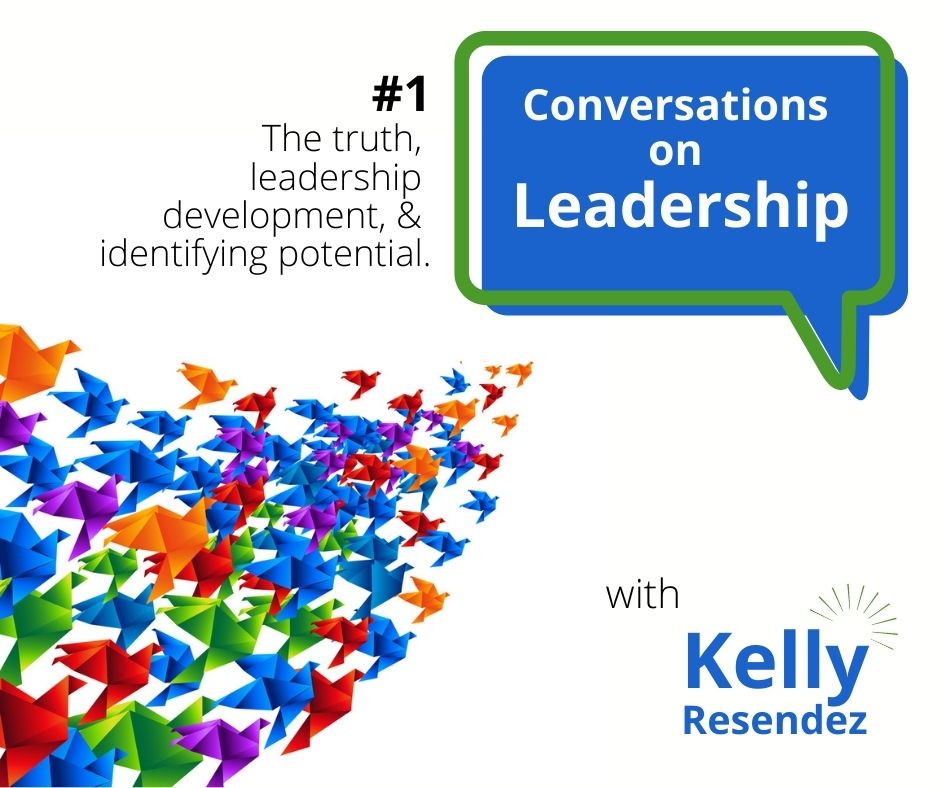Conversations on Leadership w/ Kelly Resendez: #1 The truth, leadership development, and identifying potential

Biohacking your way to health and happiness. ⚡️
October 14, 2021
Conversations on Leadership w/ Kelly Resendez: #2 The age gap, leadership training, and are great leaders born or made?
January 18, 2022Conversations on Leadership w/ Kelly Resendez: #1 The truth, leadership development, and identifying potential

As I sat down to write a few thoughts on leadership for my blog this month, my notes quickly grew past the confines of a single post (that someone would actually take the time to read!).
That’s fitting for the topic of leadership, as it’s not something we can define, illuminate, and nurture with a few paragraphs or a top-10 list. Instead, leadership is one of the most fundamentally imperative qualities in many areas of our life, from relationships to self-achievement and certainly at work.
So, I decided to create a series of blog posts for you, each one taking a few smaller – but just as important – parts of the leadership phenomenon and examining them thoroughly before giving you some sound advice.
To begin today, I will delve into three important aspects of leadership: the stakes for businesses and companies, leadership development, and identifying potential leaders.
I hope you enjoy it and get something substantive to take away – and I’m already looking forward to our next conversation!
-Kelly Resendez
The truth about corporate leadership today
The stakes have never been higher for companies, businesses, and organizations when it comes to finding, hiring, and nurturing leaders. It’s as vital to their future success as any other enterprise.
According to a recent report by the 2021 Global Leadership Forecast, companies and businesses are facing a dire leadership shortage. Only 11% of survey respondents feel they have “very strong” or “strong” leadership in place, which is the lowest benchmark in the last ten years.
And a paltry 10% of CEOs believe that the leadership development programs their company has in place are even making a clear impact on the bottom line.
In fact, 79% of employees will quit after feeling underappreciated by their managers and company leaders.
Putting the wrong people in positions of leadership can be catastrophic to an organization. We just have to follow the news cycle to see leaders fall from grace, whether it’s the CEO of a company, a politician, or other notable people.
Leadership does not just affect those in the boardroom or the C-suite but impacts all the way through the organizational ranks.
Leadership development
Training and developing leaders is big business. Leadership training was a $357.7 billion industry worldwide in 2020 and topped $165.3 billion in the U.S. and Canada alone.
It’s no mystery why companies and organizations invest huge sums into hiring and developing their captains.
But despite these impressive sums, the push to groom tomorrow’s leaders still isn’t resonating with most organizations. As of 2019, 77% of all organizations polled report that they face a leadership gap.
Looking under the hood, it’s not hard to see why. A mere 5% of companies have integrated leadership development into their organization, and 58% of managers say that they received NO management training on the way to their job or even in their current role of leadership. (Sources: GoRemotely.net and Linkedin Pulse – see below for links.)
More than three-quarters of organizations (77%) now report that leadership is insufficient within their ranks, and 83% of companies now report developing future leaders is crucial.
Identifying leadership potential
Now the hard part: how can we identify natural leaders or those with leadership potential? It’s not enough to take current CEOs and leaders and reverse engineer their qualities. Instead, we’re tasked with identifying those who may blossom into those roles early on.
According to Psychology Today, most successful leaders have these inherent traits:
- Score high marks on social intelligence scales.
- Highly adaptable and embrace – not fear or resist – change.
- Self-awareness and the capacity to step out of themselves and their situation.
- Discipline.
- A high level of focus to stay on track with the most important tasks and issues that truly warrant their attention.
Other industrial psychology studies posit that some of the most important qualities in young, new, or under-utilized employees include:
- Natural communicators, which includes great listening skills.
- Humility and self-awareness while at the same time having inner confidence.
- They want to take on responsibility but have no issues being held accountable or responding to constructive criticism.
- They’re engaged, energetic, and focused on their work – and that attitude spreads to others.
- They show initiative and always are looking to learn or improve.
- Their co-workers, their team, and the organization always come first.
Granted, that’s an ambitious list and incredibly difficult to spot from the other side of a cubicle, at the company picnic, or in passing in the hallways.
But, as we’ll learn in future conversations, there are ways businesses of any size (and budget) can reaffirm their leadership development efforts, allowing them to find and nurture the CEOs, managers, and visionaries of tomorrow.
***




